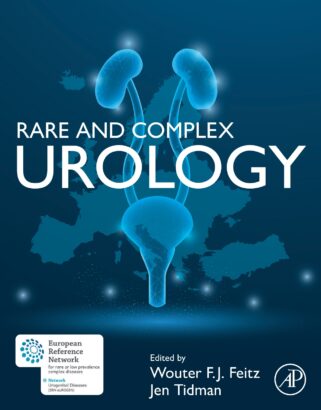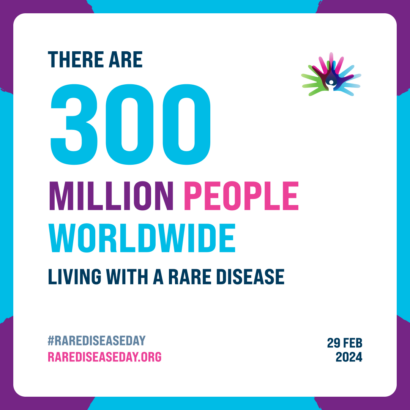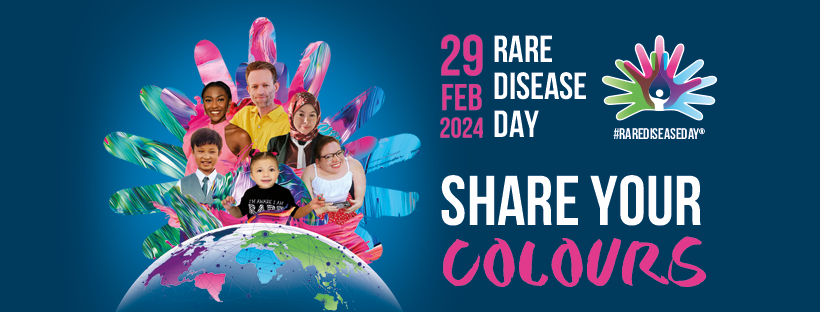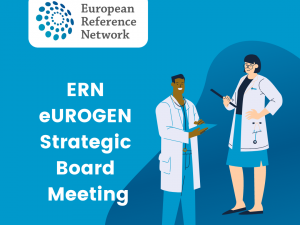 Rare Disease Day 2024 marks a significant milestone for ERN eUROGEN, the European Reference Network for Rare Uro-Recto-Genital Diseases and Complex Conditions, as it unveils the groundbreaking publication “Rare and Complex Urology.” This comprehensive book stands as an indispensable resource for clinicians and basic scientists delving into translational urology and surgery, catering to the needs of urologists and paediatric surgeons, as well as multidisciplinary team members seeking insights into novel research implementation.
Rare Disease Day 2024 marks a significant milestone for ERN eUROGEN, the European Reference Network for Rare Uro-Recto-Genital Diseases and Complex Conditions, as it unveils the groundbreaking publication “Rare and Complex Urology.” This comprehensive book stands as an indispensable resource for clinicians and basic scientists delving into translational urology and surgery, catering to the needs of urologists and paediatric surgeons, as well as multidisciplinary team members seeking insights into novel research implementation.
To fully appreciate the significance of this landmark text, it is essential to delve into the realm of rare diseases, including rare and complex uro-recto-genital conditions, understand their societal challenges, and acknowledge the pivotal role of European Reference Networks like ERN eUROGEN in advancing diagnoses and treatments for rare disease patients and their families.
Rare Diseases:
Definitions vary, but rare diseases (also known as orphan diseases) are generally characterised by low prevalence; in the United States, a disease is considered rare if it affects fewer than 200,000 people at any given time, or in the EU, if it affects fewer than 1 in 2,000 people.
They affect individuals across age groups, races, and genders and can stem from genetic, environmental, infectious, or unknown origins, presenting chronic, progressive, and life-threatening challenges.
While each rare disease affects only a small number of people, they have huge collective impacts, with an estimated 36 million individuals in the EU alone grappling with rare diseases.
Rare and Complex Urology:

Rare and complex urology refers to a subspecialty within urology dealing with diagnosing and managing uncommon, intricate, or challenging conditions affecting the urinary system and reproductive organs. These conditions may include congenital anomalies, reconstructive procedures, tumours, and other complicated cases necessitating specialised expertise and advanced surgical techniques.
As noted earlier, the EU considers a condition rare when it affects fewer than 1 in 2,000 people (<0.05%), but in the case of some uro-recto-genital conditions, the prevalence rate is significantly lower; for example, female urethral diverticulum, a localised outpouching of the urethra into the anterior vaginal wall, has an estimated annual incidence of 17.9 per 1,000,000 (0.02%) per year.
Societal Challenges:
Rare diseases present numerous societal challenges, largely due to their aforementioned complex nature, low prevalence, and often devastating impacts on individuals and families. Some of the key societal challenges posed by rare diseases include:
- Limited Access to Care: Patients may struggle to access specialised healthcare services and expertise due to geographic barriers, limited availability of specialists, and lack of awareness among healthcare providers. This can result in disparities in care and outcomes.
- Diagnostic Delays: Many rare diseases are not well-known or understood by healthcare professionals, which can lead to delays in diagnosis. Patients may go through a “diagnostic odyssey”: years of uncertainty and misdiagnosis before receiving an accurate diagnosis, leading to unnecessary suffering and progression of the disease.
- Treatment Issues: Due to the low prevalence of rare diseases, there is often limited research and investment in developing treatments. As a result, many rare diseases have no approved treatments or therapies available, leaving patients with few options for managing their conditions. Where treatments are available, healthcare professionals may be unaware of the appropriate pathway or, in the case of surgery, not experienced enough to perform it appropriately.
- Financial Burden: Rare diseases can impose significant financial burdens on patients and their families. Costs may include medical expenses, specialised treatments, assistive devices, home modifications, and caregiving expenses. The high costs associated with rare diseases can lead to financial hardship, particularly for families without adequate insurance coverage or financial resources. There is also an economic burden on national healthcare systems.
- Psychosocial Impact: Rare diseases can have profound psychosocial effects on patients and their families, including stress, anxiety, depression, social isolation, and stigma. Coping with the challenges of living with a rare disease, such as uncertainty about the future and difficulty finding support networks, can take a significant toll on mental health and well-being.
- Education and Awareness: There is often a lack of public awareness and understanding of rare diseases, which can contribute to misconceptions, stigma, and discrimination against affected individuals. Educating the public, healthcare professionals, policymakers, and the media about rare diseases is crucial for raising awareness, promoting early diagnosis, and advocating for better support and resources.
- Research and Innovation: Research into rare diseases faces unique challenges, including small patient populations, limited funding opportunities, and difficulties conducting clinical trials. Collaborative efforts among researchers, clinicians, industry partners, and patient advocacy groups are essential for advancing scientific knowledge, developing new therapies, and improving outcomes for individuals with rare diseases.
Addressing these societal challenges requires a multifaceted approach involving stakeholders across the healthcare system, government agencies, research institutions, industry, and patient advocacy organisations. Efforts to raise awareness, improve access to care, increase research funding, and support innovation are critical for addressing the needs of individuals and families affected by rare diseases.
European Reference Networks (ERNs) & ERN eUROGEN
Twenty-four ERNs covering a variety of medical disciplines were formally approved, accredited, and launched by the European Commission in March 2017. With subsequent expansions, they currently involve 1,619 highly specialised centres located in 382 hospitals across 27 EU countries and Norway, and they have full financial support, currently provided through the EU4Health Programme and taken care of by the EC’s Health and Digital Executive Agency (HaDEA).

ERN eUROGEN is the European Reference Network for Rare Uro-Recto-Genital Diseases and Complex Conditions, and its activities are essential due to the nature of rare and complex urology, as noted above. It has 56 healthcare provider members in 20 EU member states, caring for around 12,500 patients per year diagnosed with over 110 diseases and conditions with distinct ORPHAcodes and/or ICD-10 codes.
In the book Rare and Complex Urology, a section is dedicated to each workstream within ERN eUROGEN:
- WS1: rare congenital uro-recto-genital anomalies (paediatrics)
- WS2: functional uro-recto-genital conditions requiring highly specialised surgery (adults)
- WS3: rare uro-recto-genital tumours
These workstreams are further subdivided into 19 expertise areas, and in the book, each has a clinical chapter written in consensus by experts from the ERN.
The book also has an opening series of overview chapters that provide information on the work packages for which ERN eUROGEN and the other ERNs carry out activities under their current grant agreements.
- Coordination:
Coordination includes the day-to-day management and operational activities of each network but also includes collaboration activities within, between, and outside of ERNs to ensure the long-term sustainability of the ERN system and better integration of the ERNs into national healthcare systems.
Patients are at the centre of ERNs; each network has a European Patient Advocacy Group (ePAG), and patient representatives are empowered and able to make a difference as key partners and active collaborators in pan-European efforts.
The ERNs can also work with non-network members as Supporting Partners, which allows collaboration with scientific societies and individual experts to support activities and develop complementary actions and innovations.
- Dissemination:
Dissemination and communication are achieved through meetings, websites, newsletters, emails, social media, publications, presentations, and promotional materials. This enables the transfer of knowledge and expertise and increases awareness for all stakeholders.
- Evaluation:
Through the ERN monitoring system, the networks collect and verify annual data from their members on their numbers of patients and surgical procedures, along with other key performance indicators, to identify areas of success and potential pitfalls and demonstrate the added value of the ERNs. The results of these data collections are presented to the EC and have already shown that the ERNs are treating an increasing number of patients with rare diseases and complex conditions.
In addition, all ERNs and their members must be periodically evaluated by an EC-appointed body every 5 years after their approval or last evaluation. The first evaluation was launched in December 2022 to identify lessons learnt, areas for improvement, and, ultimately, if the ERNs are delivering the expected patient benefits. The final results will be publicly accessible on the EC’s evaluation webpage.
- Healthcare:
 Although ERNs are not directly accessible to individual patients, with a patient’s consent and in full compliance with data protection under EU and national legislation, their case can be referred to a relevant ERN by their healthcare provider.
Although ERNs are not directly accessible to individual patients, with a patient’s consent and in full compliance with data protection under EU and national legislation, their case can be referred to a relevant ERN by their healthcare provider.
Using technological advancements, including a dedicated IT platform (an updated version of which is due in 2024), the ERN then convenes a ‘virtual’ multi-disciplinary team meeting of medical specialists to consider the patient’s information (including imaging and videos as well as case notes) and give advice on effective diagnosis and treatment, thereby facilitating cross-border cooperation.
- Patient Registries and Research:
The ERNs have received grants from the EC to set up patient registries collecting standardised, long-term data on disease progression, surgical procedures, and treatment outcomes. This data will benefit patients and their families by evaluating the efficacy of treatments and improving the quality of care over time, clinicians by giving insights into rare and complex conditions and their best treatment options, and scientists by providing sufficiently sized patient cohorts for research and new clinical trials and observational studies.
The ERNs are also involved in the European Rare Disease Research Coordination and Support Action (ERICA) and the European Rare Diseases Research Alliance (ERDERA, the follow-on to the EJP RD). In the future, ERNs will help facilitate large clinical studies to improve the understanding of diseases and allow the development of new drugs and medical devices.
- Training and Education:
The ERNs aim to transfer knowledge from the networks to educate all relevant stakeholders across Europe and the rest of the world and coordinate, promote, manage, and increase professional training activities for the next generation of healthcare professionals. They achieve this through webinar programmes, training courses, developing clinician and patient information, and mobility and exchange programmes.
- Guidelines:
There is currently a lack of evidence-based, unbiased guidelines on rare diseases. The EC funded a project dedicated to assisting the ERNs and their healthcare providers in the process of development, appraisal and implementation of clinical practice guidelines (CPGs) and clinical decision support tools (CDSTs), including methodological handbooks based on the current international “gold standards” that have been developed and used by key international and national bodies and organisations specialised in the development of CPGs and CDSTs.
The ERNs are now developing best practice recommendations for clinicians and patients to support shared decision-making and an increasing shift to more individualised patient-centred care. These guidelines, translated into all EU languages, are likely to be endorsed by European and national medical professional associations, and their widespread dissemination and uptake will facilitate best practices and change how services are delivered across the EU and worldwide.
- Support for Ukraine:
It is estimated that there are over two million Ukrainian patients with a rare or complex disease. The EC has just concluded an administrative arrangement that will help Ukrainian healthcare providers seek advice from the ERNs on their rare or complex disease patients and allow the networks to collaborate with Ukrainian competent authorities and healthcare units, thus contributing to capacity building and best practice sharing with Ukraine.
Conclusion:
 Although much work remains, the European Reference Networks (ERNs) stand as a triumph in European voluntary cooperation, embodied by knowledge generation and sharing, innovative healthcare solutions, and transformative advancements capable of impacting millions of lives.
Although much work remains, the European Reference Networks (ERNs) stand as a triumph in European voluntary cooperation, embodied by knowledge generation and sharing, innovative healthcare solutions, and transformative advancements capable of impacting millions of lives.
The unveiling of the book “Rare and Complex Urology” by ERN eUROGEN on Rare Disease Day 2024 marks a pivotal moment in the field of urology, offering hope to individuals worldwide grappling with rare uro-recto-genital diseases and complex conditions.
As the ERNs forge ahead, a bright future beckons. Embracing the principles of collaboration, innovation, and compassion, these networks epitomise the spirit of collective action, poised to redefine the landscape of rare disease management and inspire generations to come.





